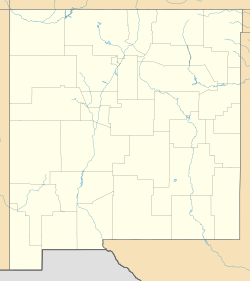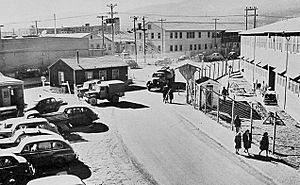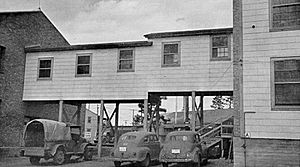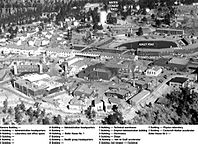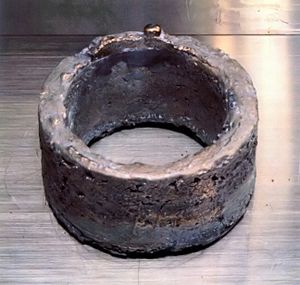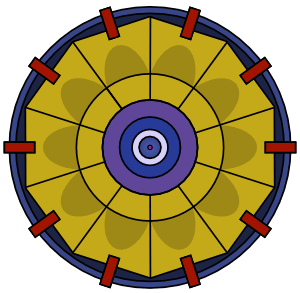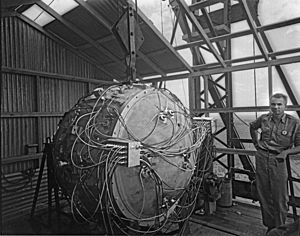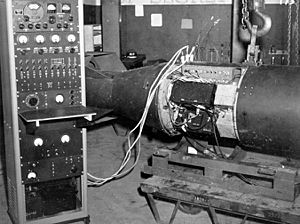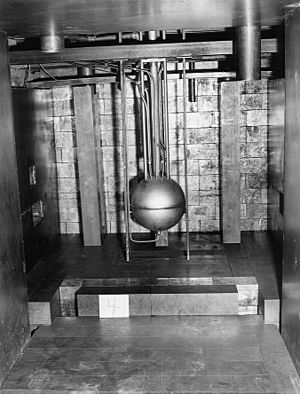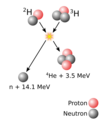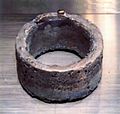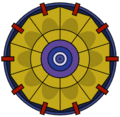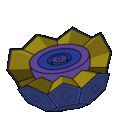Project Y facts for kids
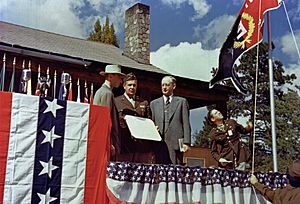
Robert Oppenheimer (left), Leslie Groves (center) and Robert Sproul (right) at a ceremony for the Los Alamos Laboratory on 16 October 1945
|
|
| Established | 1 January 1943 |
|---|---|
| Research type | Classified |
| Budget | $57.88 million |
|
Field of research
|
Nuclear weapons |
| Director | Robert Oppenheimer Norris Bradbury |
| Location | Los Alamos, New Mexico, United States 35°52′50″N 106°18′14″W / 35.88056°N 106.30389°W |
|
Operating agency
|
University of California |
|
Los Alamos Scientific Laboratory
|
|
| Location | Central Ave., Los Alamos, New Mexico |
| Built | 1943 |
| Architectural style | Bungalow/Craftsman, Modern Movement |
| NRHP reference No. | 66000893 |
| Added to NRHP | 15 October 1966 |
The Los Alamos Laboratory, also known as Project Y, was a top-secret laboratory created during World War II. It was part of the Manhattan Project and run by the University of California. Its main goal was to design and build the first atomic bombs.
Robert Oppenheimer was the first director, from 1943 to December 1945. He was then replaced by Norris Bradbury. The lab was built in a remote part of New Mexico. This allowed scientists to talk freely about their work while keeping it safe from enemies. The lab used buildings that were once part of the Los Alamos Ranch School.
Scientists first worked on a gun-type fission weapon using plutonium, called Thin Man. But in April 1944, they found that plutonium from nuclear reactors had too much plutonium-240. This would cause the bomb to explode too early, before it was fully ready. Oppenheimer then changed the lab's focus. They worked hard on a different design, an implosion-type nuclear weapon, called Fat Man. They also developed a simpler gun-type bomb, called Little Boy, which used uranium-235.
Chemists at Los Alamos learned how to clean uranium and plutonium. Plutonium was a new metal that only existed in tiny amounts when the project started. Scientists found that plutonium had surprising features. But they still managed to shape it into metal spheres. The lab also built the Water Boiler, a special reactor. It was the third reactor in the world to start working.
The Fat Man design was tested in the Trinity nuclear test in July 1945. People from Project Y helped build and load the bombs. They also went on the planes during the atomic bombings of Hiroshima and Nagasaki. After the war, the lab helped with the Operation Crossroads nuclear tests. In 1947, the Los Alamos Laboratory changed its name to Los Alamos Scientific Laboratory.
Contents
How the Lab Started
The Idea of Atomic Bombs
In 1932, James Chadwick discovered the neutron. Then, in 1938, chemists Otto Hahn and Fritz Strassmann found out about discovery of nuclear fission. This is when an atom's core splits apart. Soon after, physicists Lise Meitner and Otto Frisch explained how it worked. This discovery made people think about creating a controlled nuclear chain reaction using uranium.
At first, few scientists in the United States thought an atomic bomb was possible. But some scientists who had left Nazi Germany and other countries were worried. They feared that Germany might build atomic weapons. This led to the Einstein–Szilard letter. It was sent to President Franklin D. Roosevelt to warn him. This started early research in the U.S. in late 1939.

Things moved slowly in the U.S. But in Britain, Otto Frisch and Rudolf Peierls studied how to build atomic bombs. They found that a chain reaction could happen with just 1 kilogram (2.2 pounds) of uranium-235. This could release as much energy as hundreds of tons of TNT. Their boss, Mark Oliphant, shared their findings. This led to the MAUD Committee in Britain. In July 1941, the MAUD Committee said an atomic bomb was possible by 1943. Britain then started its own project called Tube Alloys.
The U.S. was not yet in World War II, so there was less urgency. Oliphant flew to the U.S. in August 1941. He talked to American scientists like Ernest Lawrence at the University of California. He convinced them that an atomic bomb was possible. Lawrence then asked his friend, Robert Oppenheimer, to check the physics.
In December 1941, Arthur Compton was put in charge of bomb design. He gave the job of bomb design to Gregory Breit, and Oppenheimer became his assistant. But Breit left in May 1942. Compton then chose Oppenheimer to take over. John H. Manley helped Oppenheimer by connecting different physics groups across the country. Oppenheimer and Robert Serber studied how neutrons moved in a chain reaction. They also looked at how the explosion would behave.
Bomb Design Ideas
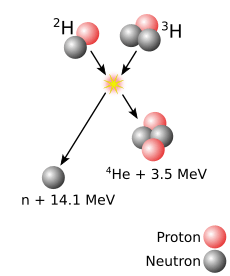
Oppenheimer and Enrico Fermi held meetings to review the work. They met at the University of Chicago in June and at the University of California in Berkeley in July. Many smart physicists attended these meetings. They agreed that a fission bomb was possible in theory.
But many things were still unknown. They didn't know much about pure uranium-235. Even less was known about plutonium. This element had only been found in February 1941. Scientists thought about making plutonium in nuclear reactors. But no reactor had been built yet. Only tiny amounts of plutonium were available.
There were different ways to put the bomb's material together. One idea was to shoot a "plug" into a sphere of "active material." This sphere would have a "tamper" around it. The tamper was a dense material that would focus neutrons inward. This would make the bomb more powerful. They also thought about using a "spheroid" shape. This was an early form of "implosion."
After discussing fission bombs, the Berkeley meeting looked at a more powerful bomb. Edward Teller wanted to talk about the "Super," now called a "hydrogen bomb." This bomb would use a fission bomb to start a nuclear fusion reaction. This reaction would happen between deuterium and tritium. Teller had many ideas, but Hans Bethe rejected them. The fusion bomb idea was put aside to focus on fission bombs.
Why a Secret Lab?
Oppenheimer's skill at leading the July meeting impressed everyone. He saw that they understood the physics. But much more work was needed on the engineering, chemistry, and other parts of building a bomb. He believed that bomb design needed a place where people could talk freely. This would stop wasted effort. He thought the best way to keep things secret was to build a central lab in a hidden place.
General Leslie R. Groves Jr. became the head of the Manhattan Project in September 1942. He met Oppenheimer and liked his idea for a separate bomb design lab. Groves, Oppenheimer, and other officers discussed how to create and run this lab. On October 19, Groves approved the new bomb laboratory. It was called Project Y.
Oppenheimer seemed like the right person to lead the new lab. But he didn't have much experience running big projects. Some people worried about this. Also, Oppenheimer didn't have a Nobel Prize, unlike other project leaders. This made some wonder if he had enough respect to lead top scientists. There were also concerns about his friends and family. Many of them were active members of the Communist Party. But Groves personally approved Oppenheimer for the job in July 1943.
Choosing the Location
They thought about putting Project Y at other labs. But they decided a remote location would be best. A site near Los Angeles was rejected for security reasons. One near Reno, Nevada, was too hard to reach. Oppenheimer suggested an area near Albuquerque, New Mexico. He owned a ranch there. The weather was mild, and it had good connections for travel. It was also far from the West Coast, so a Japanese attack wasn't a worry. Plus, not many people lived there.
In October 1942, Major John H. Dudley looked at several sites. He suggested one near Jemez Springs. But Oppenheimer worried the high cliffs would make people feel trapped. Engineers also worried about floods. Then they visited the area around the Los Alamos Ranch School. Oppenheimer loved this site. He thought its beauty would inspire the scientists. Engineers worried about the bad road and water supply. But they still thought it was a great spot.
The United States Under Secretary of War, Robert P. Patterson, approved buying the site on November 25, 1942. The government bought 54,000 acres (22,000 hectares). Most of this land was already owned by the government. The Secretary of Agriculture allowed the War Department to use more land. The total land bought for the project was 45,737 acres (18,509 hectares). The Los Alamos Ranch School cost $350,000. Other land was bought or taken by the government. This was done to make sure no private people could enter the area.
Building the Lab
The Los Alamos Ranch School already had 54 buildings. These included houses, dorms, and other living spaces. There was also a sawmill, ice house, barns, and garages. Nearby, the Anchor Ranch had four houses and a barn. The Albuquerque Engineer District oversaw the building work. Willard C. Kruger and Associates designed the buildings. Black & Veatch designed the utilities.
The first building contract went to the M. M. Sundt Company. Work started in December 1942. Groves first set aside $300,000 for building. This was three times Oppenheimer's guess. The work was supposed to finish by March 15, 1943. But it quickly became clear that Project Y was much bigger than expected. By the time Sundt finished in November 1943, over $7 million had been spent.
Oppenheimer first thought 50 scientists and 50 technicians would be enough. Groves increased this to 300. But the actual population, including families, grew to about 3,500 by the end of 1943. It reached 10,000 by the end of 1946. The best places to live were the six old log and stone cottages. These had been for the school's headmaster and teachers. They were the only homes with bathtubs and were called "Bathtub Row." Oppenheimer lived on Bathtub Row.
Other housing included apartments built by Sundt. These were two-story buildings with four families in each. They had two or three bedrooms, a kitchen with a coal stove, and a small bathroom. More homes were built by other companies. Sometimes, there weren't enough homes. People had to stay in temporary places.
A school was started in 1943 for both grade school and high school kids. It had 140 students at first, growing to 350 by 1946. Education was free, and there was a nursery school for working mothers. Many technical buildings were also built. Most were temporary, made with gypsum board. They were heated by a central plant.
The town grew so fast that the sewage system couldn't keep up. By late 1945, there were power outages. Lights had to be turned off during the day. Water also ran short. In December 1945, pipes froze, cutting off the water supply completely. Residents had to get water from tanker trucks.
Because its name was secret, Los Alamos was called "Site Y." Residents called it "The Hill." People living there couldn't vote in New Mexico elections. But they still had to pay state income taxes. It took many legal battles for Los Alamos residents to become full citizens of New Mexico in 1949. Birth certificates for babies born there listed their birthplace as PO Box 1663 in Santa Fe. All mail went through that address.
At first, Los Alamos was supposed to be a military lab. Scientists like Oppenheimer would join the Army. But some key physicists didn't like this idea. So, they made a deal: the University of California would run the lab. The university handled money and buying supplies. The plan was to make it military when the bomb was ready. But the lab grew too big. It was decided it wasn't needed, as civilians were working on dangerous tasks without problems.
How the Lab Was Organized
Military Presence
Colonel John M. Harman was the first military commander at Los Alamos. He started in January 1943. Los Alamos became a military base on April 1, 1943. He was followed by other commanders. The post commander reported directly to Groves. He was in charge of the town, government property, and military staff.
Four military groups were at the base. The MP Detachment, which were military police, arrived in April 1943. They guarded 44 posts 24 hours a day. The Provisional Engineer Detachment (PED) did jobs like working in the boiler plant and maintaining buildings.
The 1st Provisional Women's Army Auxiliary Corps (WAAC) Detachment arrived in April 1943. It later became the Women's Army Corps (WAC). These women worked as cooks, drivers, and telephone operators. Some also worked as librarians, clerks, and hospital technicians. A few even did specialized scientific research inside the Technical Area.
The Special Engineer Detachment (SED) started in October 1943. It was made up of men with technical skills or advanced education. These men worked in all parts of the Los Alamos Laboratory.
Civilian Scientists
As the lab's director, Oppenheimer reported directly to Groves. He was in charge of all the science and technology. He gathered his team from groups already working on neutron calculations. Many famous scientists joined, bringing valuable equipment. For example, Robert R. Wilson's group brought a cyclotron from Harvard University.
Communication with the outside world was limited. At first, there was only one phone line. Later, more Army phone lines were added. There were also teletypewriters for coded messages. Phones were in offices but not in homes for security reasons. Public phones were available for emergencies. Classified information could not be discussed over the phone.
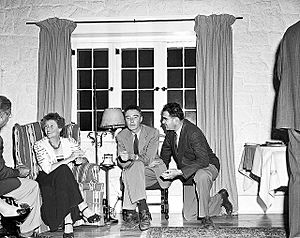
Women at Los Alamos were encouraged to work. This was because of a shortage of workers and security concerns. By September 1943, about 60 wives of scientists worked in the Technical Area. Many women worked in administration. But many, like Lilli Hornig and Jane Hamilton Hall, were scientists and technicians. Charlotte Serber led the library group. A large group of women did calculations. Dorothy McKibbin ran the Santa Fe office.
The Los Alamos Laboratory had a governing board. Oppenheimer was on it, along with other key leaders. The lab was divided into five main parts: Administration, Theoretical Physics, Experimental Physics, Chemistry and Metallurgy, and Ordnance and Engineering. All these parts grew bigger during the war. Getting security clearance was a challenge. Groves allowed a faster process for scientists to get access.
The lab also had a British Mission led by James Chadwick. British scientists like Otto Frisch and Ernest Titterton joined. Later, Niels Bohr and his son Aage Bohr also came. Geoffrey Taylor, an expert on how liquids move, helped understand explosions. The British scientists worked closely with the American teams. But they were not allowed to work on plutonium chemistry. After the war, a new law meant all British government employees had to leave. The British Mission ended in April 1947.
Gun-Type Bomb Design
Early Research
In 1943, efforts focused on a gun-type fission weapon using plutonium. It was called Thin Man. The names for the three atomic bomb designs—Fat Man, Thin Man, and Little Boy—were chosen by Robert Serber based on their shapes. Thin Man was long, named after a detective novel. Fat Man was round, named after a character in The Maltese Falcon. Little Boy was named after another character from the same movie.
Meetings in April and May 1943 set the lab's plans. Oppenheimer estimated the critical mass for a uranium-235 device. This was based on early theories. But it was only a guess. It assumed neutrons moved in simple ways. Hans Bethe's Theoretical Division worked on better models. Bethe and Richard Feynman also created a formula for how efficient the reaction would be.
Many things were still unknown. The exact properties of uranium-235 were not fully understood. Even less was known about plutonium. Measuring these values was a top priority. But the lab had only 1 gram of uranium-235 and tiny amounts of plutonium. Robert Bacher's Experimental Physics Division took on this task. In July 1943, they measured how many neutrons were released when plutonium split. They found that plutonium-239 released about 1.2 times more neutrons than uranium-235. Other experiments showed that splitting atoms happened very quickly.
John von Neumann visited Los Alamos in September 1943. He talked about how much damage an atomic bomb would cause. He explained that for large explosions, the damage depends on the peak pressure. This pressure is related to the bomb's energy. Bethe then calculated that a 10-kiloton explosion would cause severe damage within 3.5 kilometers (2.2 miles). Von Neumann also suggested that exploding the bomb high in the air would increase the damage.
Developing the Gun
W. S. "Deak" Parsons became the head of the Ordnance and Engineering Division in June 1943. He brought in experts to help. The division was split into groups. These groups worked on things like testing, instruments, fuses, and the bomb's parts.
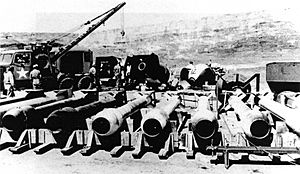
A testing ground was set up at the Anchor Ranch. The gun for the bomb would be special. It had to be designed without knowing the exact critical mass. The gun needed to shoot a projectile very fast. It also had to be light and made of special steel. It would only be fired once. So, it didn't need the usual parts of a gun.
While waiting for the guns to be made, they tested different propellants. Test firings were done at Anchor Ranch. This helped them fine-tune their testing tools. The first two gun tubes arrived in March 1944. Testing began. They also tested the fusing systems. These included radar altimeters and proximity fuses.
They tested a new radar altimeter called Archie. It was originally for tail warning in planes. It was delivered to Los Alamos in April 1944. In May, they tested it by flying a plane. This was followed by full-scale drop tests in June and July. These tests were very successful. Archie was chosen for the bomb. Testing of Silverplate Boeing B-29 Superfortress planes with Thin Man bomb shapes happened in March and June 1944.
Plutonium Challenges
In November 1942, James Chadwick worried that alpha particles from plutonium could create neutrons. These neutrons could cause the bomb to explode too early. Oppenheimer and Glenn Seaborg had thought about this. Seaborg calculated that impurities like boron had to be kept to very low levels. There were doubts if chemicals could be made that pure. But scientists believed they could meet the strict purity needs.
Only tiny amounts of plutonium were available at first. But when the X-10 Graphite Reactor started in November 1943, more became available. There were already some problems. Plutonium fluoride sometimes looked light, sometimes dark. When they made plutonium metal in November 1943, its density was much lower than expected. This was bad, as it meant more plutonium would be needed for a bomb. Chemists soon learned how to make the right kind of plutonium fluoride. By March 1944, measurements showed the density was as expected.
Eric Jette's Plutonium Metallurgy Group started working with plutonium metal in March 1944. They found that plutonium changed properties at different temperatures. It had multiple forms, called allotropes. They also found it melted at a lower temperature than expected. Chemists then worked on removing impurities. But on July 14, 1944, Oppenheimer said this was no longer needed.
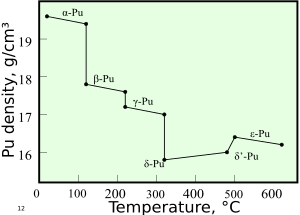
The idea of spontaneous fission (atoms splitting on their own) had been discussed since 1939. It was observed in Britain and the Soviet Union in 1940. If plutonium split too often on its own, the gun-type bomb might not work. Scientists at Los Alamos thought this was not true for plutonium.
Emilio Segrè's Radioactivity Group set out to measure spontaneous fission in different elements. They worked in a remote log cabin to avoid background radiation. By August 1943, they had good measurements for most elements. But they couldn't measure plutonium accurately. In April 1944, they got a sample from the X-10 Graphite Reactor. Tests showed a very high rate of spontaneous fission. This was too high for the gun-type bomb to work.
The problem was plutonium-240, an isotope that had not been discovered yet. It was created when plutonium-239 absorbed a neutron. Segrè's group found it had a very high spontaneous fission rate. This meant plutonium from reactors could not be used in a gun-type weapon. The plutonium-240 would start the chain reaction too fast. This would cause the bomb to explode too early. A faster gun was not practical. Separating the isotopes was also too hard.
Implosion Bomb Design
Work on a different bomb design, called implosion, had already started. Seth Neddermeyer's group was working on it. The idea was to use explosives to crush a small amount of fissile material. This would make it smaller and denser. When the atoms are packed closer, they form a critical mass. The metal only needs to move a short distance. So, the critical mass is put together much faster than with the gun method. Using explosives this way was a new idea at the time.
In 1943, implosion was a backup plan. But physicists like Bethe and Oppenheimer were interested. It would use fissile material more efficiently. This was a big plus for Groves. But implosion was much harder to figure out than the gun design. In July 1943, Oppenheimer asked John von Neumann for help.
Von Neumann visited Los Alamos in September 1943. He suggested using high-explosive shaped charges to implode a spherical core. A meeting decided to ask George Kistiakowsky, an explosives expert, to join the lab. He joined in November 1943. He became Parsons' deputy for implosion. The maximum size of the bomb was set by the size of the B-29 bomber's bomb bay.

By July 1944, Oppenheimer decided plutonium could not be used in a gun design. He chose implosion instead. The intense work on the implosion design, called Fat Man, began in August 1944. Oppenheimer reorganized the lab to focus on it. Two new groups were created: X Division for explosives and G Division for the bomb itself.
The new design used explosive lenses. These lenses focused the explosion onto a sphere. They used both slow and fast high explosives. Designing these lenses was hard and took a long time. They tested different explosives. They finally chose composition B as the fast explosive and baratol as the slow one. The final design looked like a soccer ball. It had 20 hexagonal and 12 pentagonal lenses. Each weighed about 80 pounds (36 kg). Getting the explosion just right needed fast, reliable electrical detonators. They used exploding-bridgewire detonators, a new invention from Los Alamos.
To study how shock waves moved, Robert Serber created the RaLa Experiment. This used a radioactive material that gave off gamma radiation. The material was placed in the center of a metal sphere. This sphere was surrounded by explosive lenses. This allowed them to take an X-ray movie of the implosion. This series of tests was very important for the final bomb design.
Inside the explosives was a thick aluminum pusher. This helped transfer the force smoothly. Next was a thick tamper of natural uranium. Its main job was to hold the critical mass together as long as possible. It would also reflect neutrons back into the core. To prevent early explosions, the tamper was coated in a thin layer of boron.
A special neutron initiator, called an "urchin," was developed. It used polonium-beryllium to start the chain reaction at the exact right moment. This work was done by Charles Allen Thomas's team. The whole bomb was put inside a duralumin casing. This protected it from bullets and flak.
The metallurgists had to figure out how to cast plutonium into a sphere. Plutonium is brittle at room temperature. But it becomes soft at higher temperatures. They found that mixing plutonium with gallium made it stable at room temperature. This mixture could be pressed into the right spherical shape. Plutonium also corrodes easily, so the sphere was coated with nickel.
The work was dangerous. By the end of the war, many chemists and metallurgists had to stop working with plutonium. This was because high levels of the element were found in their bodies. A small fire in January 1945 led to fears of contamination. Groves approved building a new facility for plutonium work. The first plutonium core was made and delivered on July 2, 1945. Three more were delivered later that month.
Little Boy
After Oppenheimer reorganized the lab in July 1944, work on the uranium gun-type weapon focused on Francis Birch's group. This was a backup plan in case the implosion bomb failed. The gun-type bomb now only needed enriched uranium. This made the Thin Man design much simpler. A very fast gun was no longer needed. A simpler, shorter weapon could be used. This new design was called Little Boy.
The first enriched uranium arrived from Oak Ridge in March 1944. Shipments of highly enriched uranium started in June 1944. The metallurgists didn't get any until August 1944. In the meantime, the Chemistry and Metallurgy Division experimented with uranium hydride. But this idea was dropped by August 1944.
Frank Spedding's Ames Project had a way to make uranium metal. But Cyril Stanley Smith worried about using it with highly enriched uranium. This was because of the danger of creating a critical mass. Highly enriched uranium was also very valuable. He wanted to avoid losing even a tiny bit. So, Richard D. Baker adapted the process for Los Alamos. In February, Baker's group made many reductions with highly enriched uranium tetrafluoride.
Two types of gun designs were made. Type B was chosen for production because it was lighter. The primers and propellant were the same as for Thin Man. Small-scale tests were done. Full-scale tests started in December. The first test case made was the best ever. It was used in four tests and later in the Little Boy bomb for Hiroshima. The design was finished in February 1945. Different parts were made at three separate plants. This was to keep the complete design secret.
No full test of a gun-type nuclear weapon happened before Hiroshima. There wasn't enough uranium-235 for a test. Also, the design was simple. Scientists were almost sure it would work. Thirty-two drop tests were done. Only once did the bomb fail to fire. One last change was made to allow the propellant bags to be loaded in the bomb bay.
Safety was a concern. Little Boy had basic safety features. But an accidental explosion could still happen. Tests showed that a crash would need a huge impact to cause a nuclear explosion. This made it very unlikely. But there was still worry that a crash and fire could trigger the explosives. If the uranium halves were in water, it could cause widespread radioactive contamination. So, pilots were told to crash on land, not at sea.
Water Boiler Reactor
The Water Boiler was a special type of nuclear reactor. It used nuclear fuel (uranium sulfate) mixed in water. Uranium sulfate was chosen because sulfur doesn't absorb neutrons as much as nitrogen. Robert Bacher suggested the project in April 1943. He wanted to measure critical masses and test materials. The Theoretical Division didn't like the idea. They thought it was a distraction. But Bacher insisted.
Not much was known about building reactors in 1943. A group was formed under Donald Kerst. Robert F. Christy helped with calculations. He estimated that 600 grams of uranium-235 would be a critical mass. At first, they planned to run the Water Boiler at 10 kilowatts. But Enrico Fermi and Samuel K. Allison visited. They warned about the uranium salt breaking down. They suggested more shielding. They also noted that radioactive products would be made. So, they decided to run it at only 1 kilowatt at first.
Christy also calculated how much area would be contaminated if there was an accidental explosion. A site called Omega was chosen in Los Alamos Canyon. It was far from the town and away from the water supply. The Water Boiler was not easy to build. The two halves of its stainless steel sphere had to be welded. The Metallurgy Group made special bricks for the tamper. The building at Omega Site was ready by February 1944. The Water Boiler was fully built by April. Enough enriched uranium arrived in May. It started working on May 9, 1944. It was only the third reactor in the world to do so.
In September 1944, the Water Boiler group became part of Fermi's division. After finishing experiments in June 1944, they decided to rebuild it as a more powerful reactor. They aimed for 5 kilowatts. This would keep cooling simple. Water cooling was added, along with more control rods. This time, uranium nitrate was used. It was easier to clean. The reactor started working in December 1944.
Project Alberta
Project Alberta, also known as Project A, was created in March 1945. Its job was to help prepare and deliver the bombs. Parsons led Project Alberta. Norman Ramsey was his scientific deputy. The project had 51 military and civilian staff. There were two bomb assembly teams. One for Fat Man and one for Little Boy.
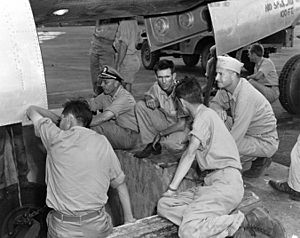
Project Alberta aimed to have the Little Boy ready by August 1. The first Fat Man would be ready soon after. Before the real missions, twelve practice missions were flown in July. They used "pumpkin bombs." These were like Fat Man but without the nuclear material. Four Little Boy practice bombs were dropped. The Little Boy team had the real bomb ready by July 31. Orders for the attack were given on July 25. They named four targets: Hiroshima, Kokura, Niigata, and Nagasaki. The attack was ordered "as soon as weather will permit after about 3 August."
Assembling a Fat Man bomb was complex. It involved teams for explosives, the core, fuses, and firing. Parsons limited how many people could be inside the assembly building at once. This was to prevent accidents. The first Fat Man practice bomb was ready by July 31. It was dropped the next day. More practice bombs followed. Three sets of Fat Man parts arrived on August 2. One set was found to be damaged. The other two were assembled. One was for a rehearsal, and one for the actual mission.
Parsons was in charge of the Hiroshima mission. He loaded the Little Boy's powder bags into the Enola Gay plane during the flight. Before reaching the target, he armed the bomb. Four other Project Alberta members were on the Hiroshima mission. Luis Alvarez, Harold Agnew, and Lawrence H. Johnston were on an instrument plane. They dropped devices to measure the blast. Bernard Waldman was a camera operator on an observation plane. But he forgot to open the camera shutter, so no film was exposed.
On August 7, the day after Hiroshima, leaders met to decide what to do next. Parsons said a Fat Man bomb would be ready by August 11. But the pilot, Paul Tibbets, said the weather would be bad then. He asked if it could be ready by August 9. Parsons agreed. For this mission, Frederick Ashworth was in charge of the bomb. Other team members were on instrument and observation planes.
Security and Spies
On March 10, 1945, a Japanese fire balloon hit a power line. This caused the Manhattan Project's reactors to shut down temporarily. This made people at Los Alamos very worried about an attack. One night, everyone stared at a strange light in the sky. Oppenheimer later said this showed that "even a group of scientists is not proof against the errors of suggestion and hysteria."
Keeping things secret was hard with so many people. A special Counter Intelligence Corps group handled security. By 1943, it was clear that the Soviet Union was trying to get secrets from the project. The most successful Soviet spy was Klaus Fuchs from the British Mission. When his spying was found out in 1950, it hurt the U.S.'s nuclear cooperation with Britain and Canada. Other spies were later found, leading to arrests.
After the War
After the war ended on August 14, 1945, Oppenheimer told Groves he wanted to resign. But he agreed to stay until a new director was found. Groves wanted someone with a strong science background and respect within the project. Oppenheimer suggested Norris Bradbury. Groves liked that Bradbury was both a military officer and a scientist. Bradbury accepted the job for a six-month trial. Groves announced this on September 18. Bradbury became the lab's second director on October 17.
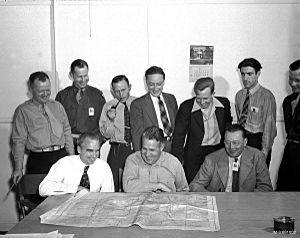
Bradbury's first months were tough. He hoped a new law would quickly create a permanent organization. But it took longer than expected. President Harry S. Truman signed the law creating the Atomic Energy Commission on August 1, 1946. It started on January 1, 1947. In the meantime, Groves' power was limited.
Most scientists at Los Alamos wanted to go back to their universities. By February 1946, all the wartime division heads had left. But a talented core group stayed. A new Z Division was created in July 1945. It controlled testing, storing, and assembling bombs. It moved to Sandia Base between March and July 1946.
The number of staff at Los Alamos dropped from over 3,000 to about 1,000. Many were still living in temporary wartime homes. Even with fewer staff, Bradbury still had to support Operation Crossroads. These were nuclear tests in the Pacific. Two ships were used for Los Alamos staff. Operation Crossroads cost the lab over one million dollars. It also used 150 staff members for nine months. About one-fifth of the U.S.'s atomic bombs were used in these tests.
The Los Alamos Laboratory became the Los Alamos Scientific Laboratory in January 1947. The University of California had the right to end its contract after the war. But they were convinced to continue. The contract was extended until July 1948. Bradbury remained director until 1970. The total cost of Project Y until the end of 1946 was $57.88 million.
Images for kids
-
Robert Oppenheimer (left), Leslie Groves (center) and Robert Sproul (right) at the ceremony to present the Los Alamos Laboratory with the Army-Navy "E" Award at the Fuller Lodge on 16 October 1945
-
In nuclear fission, the atomic nucleus of a heavy element splits into two or more light ones when a neutron is captured. If more neutrons are emitted, a nuclear chain reaction becomes possible.
-
In nuclear fusion, the nuclei of light elements are fused to create a heavier element.
-
Isidor Isaac Rabi, Dorothy McKibbin, Robert Oppenheimer and Victor Weisskopf at Oppenheimer's home in Los Alamos in 1944
-
A row of Thin Man casings. Fat Man casings are visible in the background. The tow truck was used by the 216th Army Air Forces Base Unit to move them.
-
Plutonium has six allotropes at ambient pressure: alpha (α), beta (β), gamma (γ), delta (δ), delta prime (δ'), & epsilon (ε)
-
An implosion-type nuclear bomb. In the center is the neutron initiator (red). It is surrounded by the plutonium hemispheres. There is a small air gap (white, not in the original Fat Man design) and then the uranium tamper. Around that is the aluminium pusher (purple). This is encased in the explosive lenses (gold). Colors are the same as in the diagram opposite.
-
The April 1946 colloquium on the Super. In the front row are (left to right) Norris Bradbury, John Manley, Enrico Fermi and J. M. B. Kellogg. Robert Oppenheimer, in dark coat, is behind Manley; to Oppenheimer's left is Richard Feynman. The Army officer on the left is Colonel Oliver Haywood.
-
Herbert Lehr and Harry Daghlian loading the assembled tamper plug containing the plutonium pit and initiator into a sedan for transport from the McDonald Ranch House to the Trinity shot tower
-
Deak Parsons (right) supervises loading the Little Boy bomb into the B-29 Enola Gay. Norman Ramsey is on his left, with his back to the camera.
-
Bradbury (left) examines plans for new laboratory sites and permanent housing with Leslie Groves of the Armed Forces Special Weapons Project (center) and Eric Jette (right) in April 1947; Colonel Lyle E. Seeman stands behind Bradbury, second from the left.


